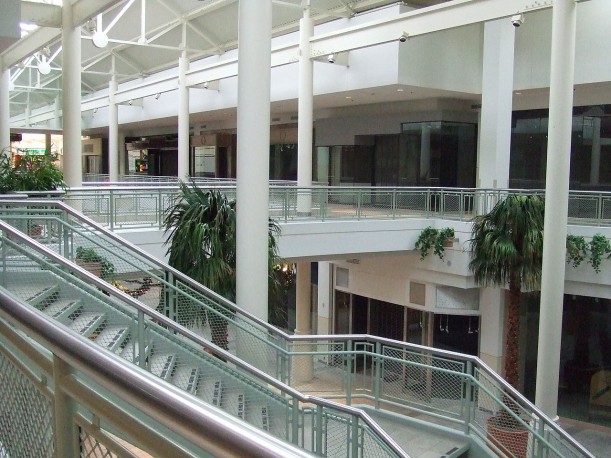The Life And Death Of The Shopping Mall

Shown is the Crossroads mall pre-demolition. By 2016, Crossroads off 72nd and Dodge was left almost empty by retailers and tenants. The malls of the past, full of fast food and retailers, are dying, making way for new concepts for communal spaces. (Karin Dalziel / Wikimedia Commons)
For the second time in two years, Oakview Mall has been put up for sale. The loss of Younkers and Sears in 2018 marked the beginning of the end for the West Omaha shopping center. The Oakview Mall turned from a commercial hub into an argumentative second option when the internet or Westroads left you high and dry.
Crossroads, Omaha’s first mall built in the mid 1900s, saw its decline begin in 2016 when Footlocker, Finished, and Restoration Church left, and the mall was only supported by rental costume stores and the occasional “community garage sale.” In the same year, Target permanently sealed its mall entrance, cutting off the last major retailer from the now ghost-town attached. Century Development and Lockwood development, who bought the failing shopping center in 2010, began reconstruction of the space in 2020. The remodel is scheduled to be done in 2025 and be the size of 30 football fields.
Malls weren’t meant to be coliseums of consumerism; they began as courtyards for communal spaces. In 17th century England, people would gather at a field to play Pall Mall, a game that is considered a predecessor of croquet. After the game fell out of fashion, these grassed promenades became known as pall malls and eventually many were replaced with shopping centers in the 20th century leading to the North American term we all know.
Shopping centers in the form of outdoor markets are not a modern concept. In the middle east, covered bazaars have existed in Iran since around 3000 BCE. In 1828, The Arcade Providence built in Rhode Island became the first shopping arcade in America. Arcade being a collection of stores beneath one roof. The growth of the suburbs and the automobile industry in America during the early 1900s brought a rise of commercial spaces away from downtowns.
The first indoor mall, The Southdale Center, was created by Victor Gruen in Edina, Minnesota in 1956. The 1950s brought about an economic boom from government spending on interstate, public school, and an increase in military spending on airplanes and computers. By the end of the “Decade of Prosperity” the average family had 30% more purchasing power than they had in the beginning. Gruen’s vision for the mall was to be a “third space” — the first space is home, the second is work — to come together and build community.
Malls continued to explode through the decades. By 1960, there were 4,500 malls open in the U.S., meaning there were almost 3 malls opening every day. By 1975, shopping malls accounted for 33% of all retail sales. Gruen had a vision for how the mall should turn out, and what was built all over the nation did not fit his mold. Food Courts filled with cheap eats were placed where courtyards were meant to be. Suburban housing projects and gigantic parking surrounded malls rather than Gruen’s ideal cosmopolitan communities. Malls were meant to dismantle the isolation of suburbia but ended up as a contributor.
The 80’s would see the golden age of Malls. Board games like mall madness let kids dream of the possibilities that wait for them in adolescence to adulthood. An array of movies such as ‘Chopping Mall’, ‘Valley Girl’ and ‘Mallrats’ all centered around the commercial hub.
The American Mall peaked in 1992 with the invention of the Mega Mall. The Mall of America opened in Minnesota, the same state as the first covered shopping center. The Mall covers 5.6 million square feet with over 500 stores, a 27-ride theme park, a movie theater, a wedding chapel and an aquarium. Consumers were reportedly 50% more likely to buy something in a mega mall than at a regular mall.
The 2000s saw the collapse of a commercial empire. With the innovation of new layouts and more grand atmospheres, the newer malls would poach anchor stores from older malls. Without the main attractions, the old malls would be left to decay.
The internet’s expansion aided in the decline of malls along with other types of retail. Store fronts are a novelty more than a necessity these days. Instead of driving to look at clothes, posters and furniture, people can stay on their couch in their pajamas and shop at stores which don’t exist where they live. In 2014, internet e-commerce generated $1.3 trillion in sales, and in 2022 the number grew to $5.7 trillion.
As the use of malls became more and more obsolete, social media also gained its traction creating less need for a “third space”, as we found our niches and communities on our smartphones.
The concept of malls is still evolving, as we can see in Omaha. The revitalization of Gene Leahy Mall and the RiverFront have returned to the concept of a mall being a “third space”, providing a place for people to congregate and enjoy their environment and one another verses bathing in consumerism. Crossroad’s renovation also seeks to create less of a consumer haven like its antiquated building. The new designs incorporate green spaces and flowered paths intertwined with businesses, apartments and community hubs, creating a more environmental urban design. The revival of the mall may just be rejuvenating the “Pall Malls” of the past to fit the average American’s future.
Category:
User login
Omaha Daily Record
The Daily Record
222 South 72nd Street, Suite 302
Omaha, Nebraska
68114
United States
Tele (402) 345-1303
Fax (402) 345-2351




